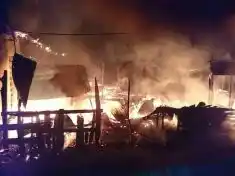The Malawi Football National Team was booted out of the African Nations Championship (CHAN) after going down 2-0 to South Africa on Sunday.
The Flames failed to defend the first leg 1-0 victory at Loftus Versfild in Durban as Victor Letsoalo broke the dead lock after 12 minutes before Neo Maema netted the second on 87th minute to seal the victory for the hosts and send them through to the CHAN finals with a 2-1 victory on aggregate.
But what went wrong for the Flames to lose the match? Football writer Erik Chiputula analyses the fallout of the flames.
*First Half*
Peter Mponda deployed his men in a 3-5-2 shape that helped them beat South Africa 1-0 last week at Bingu National Stadium. Maxwell Paipi, Nickson Mwase, and Alick Lungu formed a three-man defence while Wisdom Mpinganjira and McDonald Lameck operated in both flanks as wingbacks.
Yankho Singo and Lloyd Aaron sat in front of the defence, forming a double pivot while Wongani Lungu played as number 10. Binwell Katinji and Promise Kamwendo were twin strikers in the match.
In this formation, Mponda wanted to nullify South Africa’s wings, control the midfield, and ensure balance when attacking and defending. The intention was to break through counter-attacks, but the plan was completely disrupted by Bafana Bafana coach Molefi Ntseki’s tactical approach to the game.
In possession, only Aden McCarthy and Kwanda Mngonyama were remaining at the back as defenders. Another defender, Kegan Johanes, would switch to midfield and operate as a defending midfielder, forcing the six midfielders used in the game, in Yandisa Mfolozi (right-wingback), Siyanda Msani (left wingback), and other central midfielders, Sammy Seabi, Maphangule, Sibelebele and Maema, to push higher up the pitch, supporting the forward, Letsoalo.
These central overloads gave South Africa’s creators more passing options between the lines, and pinning Malawi further back, closer to the defensive line, resulted in a lack of central passing options for the part of Malawi and at the same time disrupted Mponda’s intention of breaking through counterattack.
Malawi’s inability to move from defence meant South Africa defenders were pushing up to 3 middle. Malawi could have taken advantage if they had a defender with progressive switch-through balls to feed front players, but it was evident we lacked such players with exceptional passing range and precision, which could break through opposition lines. With South Africans compact in midfield, we also needed, Malawi needed a technical midfielder with the ability to break down organised midfield and defence with progressive passes.
*Second half*
The introduction of Chawanangwa Gumbo, who replaced Promise Kamwendo in the second half, improved things for the Flames as tactical changes helped Malawi to match South Africa’s numbers in midfield. The substitution saw Chawanangwa Gumbo adding numbers at the centre to four midfielders.
Malawi started to create chances, with Gumbo an orchestrator of all dangerous moves from the Malawian side. Meanwhile, the problem in the second half was the lack of forwards with pace and dribbling that could stretch the defence and create space, as was evident twice when we broke with passes in the final third. Malawi forwards failed to beat the makers on 1v1; instead, they were outpaced and dispossessed.
The game also exposed the lack of depth in the team. In the last 20 minutes, some players looked very tired, particularly in wide defensive areas, but quality on the bench kept the coach guessing. The tired legs failed to cope with South Africa’s press in the dying minutes, giving advantage to the hosts to open up the defence passes that resulted in the second goal.






0 Comments